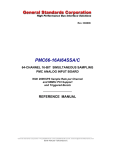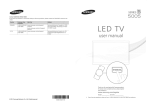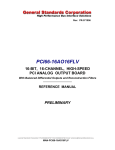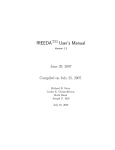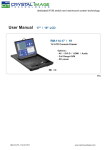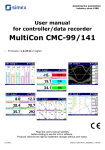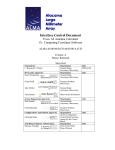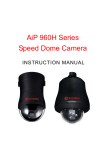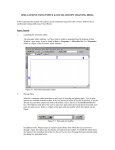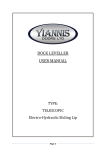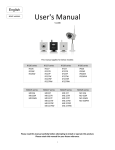Download Manual - General Standards Corporation
Transcript
Rev: 090406 PMC-12AIO 12-BIT PMC ANALOG INPUT/OUTPUT BOARD With 32 Input Channels, 4 Output Channels, And 16-Bit Digital Port _______________________ REFERENCE MANUAL ________________________________________________________________________________________ General Standards Corporation Ph:(256)880-8787 FAX:(256)880-8788 Email: [email protected] MAN-PMC-12AIO PCI-12AIO Copyright (C) 2005 General Standards Corp. Additional copies of this manual or other General Standards Co. literature may be obtained from: General Standards Corp. 8302A Whitesburg Dr. Huntsville, Alabama 35802 Telephone: (256) 880-8787 FAX: (256) 880-8788 The information in this document is subject to change without notice. General Standards Corp. makes no warranty of any kind with regard to this material, including, but not limited to, the implied warranties of merchantability and fitness for a particular purpose. Although extensive editing and reviews are performed before release to ECO control, General Standards Corp. assumes no responsibility for any errors that may exist in this document. No commitment is made to update or keep current the information contained in this document. General Standards Corp. does not assume any liability arising out of the application or use of any product or circuit described herein, nor is any license conveyed under any patent rights or any rights of others. General Standards Corp. assumes no responsibility resulting from omissions or errors in this manual, or from the use of information contained herein. General Standards Corp. reserves the right to make any changes, without notice, to this product to improve reliability, performance, function, or design. All rights reserved. No part of this document may be copied or reproduced in any form or by any means without prior written consent of General Standards Corp. General Standards Corporation Ph:(256)880-8787 FAX:(256)880-8788 Email: [email protected] PCI-12AIO TABLE OF CONTENTS SECTION 1.0 TITLE _ PAGE 1-1 INTRODUCTION 1.1 General Description 1-1 1.2 Functional Overview 1-2 2.0 INSTALLATION AND MAINTENANCE 2-1 2.1 Board Configuration 2-1 2.2 Installation 2-1 2.2.1 Physical Installation 2-1 2.2.2 Input/Output Cable Connections 2-1 2.3 2-3 System Configuration 2.3.1 Analog Inputs 2-3 2.3.1.1 Single-Ended Inputs 2-3 2.3.1.2 Differential Inputs 2-4 2.3.2 Analog Outputs 2-5 2.3.2.1 Output Configuration 2-5 2.3.2.2 Loading Considerations 2-5 2.3.3 External Sync 2-6 2.3.4 Multiboard Synchronization 2-6 2.3.5 Bidirectional Digital Port 2-7 2.4 Maintenance 2-7 2.5 Reference Verification 2-8 2.5.1 Equipment Required 2-8 2.5.2 Verification and Adjustment 2-8 3.0 3-1 CONTROL SOFTWARE 3.1 Introduction 3-1 3.2 Board Control Register (BCR) 3-1 3.3 Configuration and Initialization 3-2 3.3.1 Board Configuration 3-2 3.3.2 Initialization 3-3 __________________________________________________________________________________________ General Standards Corporation Ph:(256)880-8787 FAX:(256)880-8788 Email: [email protected] i PCI-12AIO TABLE OF CONTENTS (Continued) SECTION 3.4 TITLE Analog Input/Output Parameters _ PAGE 3-3 3.4.1 Analog Voltage Range 3-3 3.4.2 Timing Organization 3-4 3.4.3 Scan and Sync Control Register 3-4 3.4.4 Rate Generators 3-5 3.4.4.1 Scan Rate Control 3-6 3.4.4.2 Generator Cascading 3-6 3.4.5 3.5 3.5.1 Multiboard Synchronization Analog Input Control Input Data Organization 3-7 3-8 3-8 3.5.1.1 Input Data Buffer 3-8 3.5.1.2 Data Coding Format 3-8 3.5.2 Input Data Buffer Control 3-9 3.5.3 Analog Input Function Modes 3-9 3.5.3.1 Differential Inputs 3-9 3.5.3.2 Single-Ended Inputs 3-10 3.5.3.3 Selftest Modes 3-10 3.5.4 Input Scan Timing 3-10 3.5.4.1 Conversion Rate 3-10 3.5.4.2 Scan Rate 3-10 3.5.4.3 Scan Clocking Source 3-11 3.5.5 3.6 3.6.1 Scanning Modes 3-11 Analog Output Control 3-11 Output Data Organization 3-11 3.6.1.1 Output Data Buffer 3-11 3.6.1.2 Data Coding Format 3-12 3.6.2 Output Data Buffer Control 3-12 3.6.3 Output Clocking Modes 3-12 3.6.3.1 Sequential Clocking 3-13 3.6.3.2 Simultaneous Clocking 3-13 3.6.3.3 Output Clock Source 3-13 __________________________________________________________________________________________ General Standards Corporation Ph:(256)880-8787 FAX:(256)880-8788 Email: [email protected] ii PCI-12AIO TABLE OF CONTENTS (Continued) SECTION 3.6.4 TITLE _ Output Sync Modes PAGE 3-13 3.6.4.1 Continuous Outputs 3-13 3.6.4.2 Data Bursts 3-13 3.6.4.3 Output Sync Source 3-14 3.6.5 Function Looping 3-14 3.6.5.1 Periodic Function Generation 3-14 3.6.5.2 One-Shot Functions 3-15 3.6.5.3 Multiple Burst Queue 3-15 3.7 Autocalibration 3-15 3.8 Bidirectional Digital Port 3-16 3.9 Interrupt Control 3-16 3.9.1 Local Interrupt Request 3-16 3.9.2 Enabling the PCI Interrupt 3-17 3.10 3.11 4.0 3-19 DMA Operation Periodic Function Looping Examples PRINCIPLES OF OPERATION 3-20 4-1 4.1 General Description 4-1 4.2 Analog Inputs 4-2 4.3 Analog Outputs 4-2 4.4 Rate Generators 4-3 4.5 Data Buffers and Transfer FIFO's 4-3 4.6 Autocalibration 4-3 4.7 Power Control 4-4 App A Control Register Quick Reference A-1 __________________________________________________________________________________________ General Standards Corporation Ph:(256)880-8787 FAX:(256)880-8788 Email: [email protected] iii PCI-12AIO LIST OF ILLUSTRATIONS FIGURE TITLE _ PAGE 1.1-1 Physical Configuration 1-1 1.2-1 Functional Organization 1-2 2.2-1 Input/Output Connector 2-3 2.3-1 Analog Input Configurations 2-4 2.3-2 Output Configurations 2-5 2.3-3 Line Loss Versus Load Current 2-6 2.3-4 Multiboard Synchronization 2-7 2.5-1 Reference Adjustment Access 2-9 3.4-1 Clock and Sync Organization 3-4 3.4-2 Cascaded Rate Generator Example 3-7 3.5-1 Multiboard Synchronization 3-7 3.6-1 Function Burst; Output Buffer Data Flow 3-14 3.6-2 Periodic Function; Output Buffer Data Flow 3-15 4.1-1 Functional Block Diagram 4-1 __________________________________________________________________________________________ General Standards Corporation Ph:(256)880-8787 FAX:(256)880-8788 Email: [email protected] iv PCI-12AIO LIST OF TABLES TABLE TITLE _ PAGE 2.2-1 System Connector Pin Functions 2-2 2.5-1 Reference Verification Equipment 2-8 3.1-1 Control and Data Registers 3-1 3.2-1 Board Control Register (BCR) 3-2 3.3-1 Configuration Operations 3-3 3.4-1 Analog Voltage Range Selection 3-4 3.4-2 Scan and Sync Control Register 3-5 3.4-3 Rate Generator Register 3-6 3.4-4 Rate Generator Frequency Selection; Fclk=24MHz 3-6 3.5-1 Input Data Buffer 3-8 3.5-2 Input Data Coding; 12-Bit Data 3-8 3.5-3 Input Data Buffer Control Register 3-9 3.5-4 Analog Input Function Selection 3-9 3.6-1 Output Data Buffer 3-12 3.6-2 Output Data Buffer Control Register 3-12 3.8-1 Digital I/O Port 3-16 3.9-1 Interrupt Control Register 3-18 3.10-1 Typical DMA Register Configuration 3-19 3.11-1 Summary of Periodic Function Examples 3-20 3.11-2 Continuous Periodic Function; Sequential Clocking 3-20 3.11-3 Continuous Periodic Function; Simultaneous Clocking 3-21 3.11-4 Burst Periodic Function; Simultaneous Clocking 3-21 3.11-5 Burst Periodic Function, Sequential Clocking 3-22 __________________________________________________________________________________________ General Standards Corporation Ph:(256)880-8787 FAX:(256)880-8788 Email: [email protected] v PCI-12AIO SECTION 1.0 INTRODUCTION 1.1 General Description The PMC-12AIO board is a single-width PCI mezzanine card (PMC) that provides high-speed 12-bit analog input/output capability for PMC applications. 32 analog input lines can be configured either as 32 single-ended input channels or as 16 differential channels, and are digitized at rates up to 1,500,000 conversions per second. Four single-ended analog outputs can be clocked at up to 400KSPS per channel with optional accelerated scanning. The voltage range for analog inputs and outputs is software controlled as ±2.5V, ±5V or ±10V. A 16-bit bidirectional digital I/O port also is provided. The board is functionally compatible with the IEEE PCI local bus specification Revision 2.2, and is mechanically and electrically compatible with the IEEE compact mezzanine card (CMC) specification IEEE 1386. A PCI interface adapter supports the "plug-n-play" initialization concept. Power requirements consist of +5 VDC from the PCI bus in accordance with the PCI specification, and operation over the specified temperature range is achieved with conventional convection cooling. Specific details of physical characteristics and power requirements are contained in the PMC-12AIO product specification. Figure 1.1-1 shows the physical configuration of the board, and the arrangement of major components. NOTE: Representative configuration. Details may vary. PMC HOST CONNECTORS SYSTEM I/O CONNECTOR PRINTED CIRCUIT BOARD STANDOFF (4) 5.87“ (149 MM) P1 PCI INTERFACE ADAPTER U1 2.91“ (74MM) P2 ANALOG COMPONENTS SHIELD POWER CONTROL SECTION P5 LOCAL CONTROLLER U2 Figure 1.1-1. Physical Configuration The board is designed for minimum off-line maintenance, and includes internal monitoring and autocalibration features that eliminate the need for disconnecting or removing the module from the system for calibration. All system input and output connections are made through a single 68-pin, dual-ribbon front-access I/O connector. The analog outputs are set to zero-level (midrange) during initialization. __________________________________________________________________________________________ General Standards Corporation Ph:(256)880-8787 FAX:(256)880-8788 Email: [email protected] 1-1 PCI-12AIO 1.2 Functional Overview Principal capabilities of the PMC-12AIO board are summarized in the following list of features: 32 Single-Ended or 16 Differential 12-Bit Scanned Analog Input Channels 4 Analog Output Channels, 12-Bit D/A Converter per Channel 16-Bit Bidirectional Digital Port with Two Auxiliary I/O Lines Software-Selectable Analog Input/Output Ranges of ±10V, ±5V or ±2.5V Independent 32K-Sample Analog Input and Output FIFO Buffers 1.5 MSPS Conversion Rate in Single-Channel Mode; 1.0 MSPS in Multichannel Mode (1.5 MSPS with optional Accelerated Scanning) Multiple-Channel and Single-Channel Input Scanning Modes 300K Samples per Second per Channel Analog Output Clocking Rate (400K Samples per second with Optional Accelerated Scanning) Supports Waveform and Arbitrary Function Generation Continuous and One-shot Output Modes Two Independent Internal Rate Generators Supports Multiboard Synchronization of Analog Inputs and Outputs Internal Autocalibration of Analog Input and Output Channels DMA Engine Minimizes Host I/O Overhead The PMC-12AIO board contains four 12-Bit D/A converters, a 12-bit scanning A/D converter, and a 16-Bit bidirectional port with two auxiliary I/O lines. A PCI interface adapter provides the interface between the controlling PCI bus and an internal local controller (Figure 1.2-1). Gain and offset correction of the analog input and output channels is performed by calibration DAC's that are loaded with channel correction values during autocalibration I/O Conn Analog Inputs 32 S.E., 16 Diff Input Buffer Amps Selftest Switches Analog Mux Input Range Control 12-BIT ADC Loopback Voltage Reference Vtest Out Sync Input 8-Bit Calibration DAC’S AI Buffer AO Buffer PCI Conn PCI Interface Adapter Local Controller 12-Bit Output DAC’s (4) I/O Conn Analog Outputs 4 S.E. Local Bus Figure 1.2-1. Functional Organization __________________________________________________________________________________________ General Standards Corporation Ph:(256)880-8787 FAX:(256)880-8788 Email: [email protected] 1-2 PCI-12AIO The analog inputs are software-configurable either as 32 single-ended channels or as 16 differential signal pairs. Buffer amplifiers on all input lines eliminate multiplexer input switching noise, and minimize crosstalk and input bias currents. A selftest switching network routes a precision reference to the A/D converter during autocalibration, and also provides loopback monitoring of all analog output channels. Analog input data accumulates in a 32K-sample buffer until retrieved by the PCI bus. Each of the four analog output channels contains a dedicated 12-bit D/A converter, offset and gain calibration DAC's, and an output range control network. The board receives analog output data from the PCI bus through a 32K-sample FIFO buffer. Analog input scanning can be synchronized to the analog output sample clock, or the inputs and outputs can be operated independently. Both the analog inputs and outputs can be synchronized externally, and a hardware output permits multiple boards to be synchronized together. An interrupt request can be generated in response to selected conditions, including the status of the analog input and output data buffers. __________________________________________________________________________________________ General Standards Corporation Ph:(256)880-8787 FAX:(256)880-8788 Email: [email protected] 1-3 PCI-12AIO SECTION 2.0 INSTALLATION AND MAINTENANCE 2.1 Board Configuration This product has no field-alterable configuration features, and is completely configured at the factory for field use. 2.2 Installation 2.2.1 Physical Installation To minimize the opportunity for accidental damage before installation, the board should be stored in the original protective shipping envelope. System power must be turned OFF before proceeding with the installation. CAUTION: This product is susceptible to damage from electrostatic discharge (ESD). Before removing the board from the conductive shipping envelope, ensure that the work surface, the installer and the host board have been properly discharged to ground. After removing the board from the shipping envelope, position the board with the shield and standoffs facing the host (carrier) board, and with the I/O connector oriented toward the front panel. Align the two PCI connectors located at the end of the board opposite the I/O connector with the mating connectors on the host board, and carefully press the board into position on the host. Verify that the PCI connectors have mated completely and that the standoffs are seated against the host board. Attach the board to the host with four 2.5 x 6.5mm panhead screws. Pass the screws through the back of the host into the four mounting holes on the board. Tighten the screws carefully to complete the installation. Do not overtighten. 2.2.2 Input/Output Cable Connections System cable signal pin assignments are listed in Table 2.2-1. I/O connector P5 is designed to mate with a 68-pin dual-ribbon connector, equivalent to Robinson Nugent #P50E-068-S-TG. The insulation displacement (IDC) Robinson Nugent cable connector accepts two 34-wire 0.050-inch ribbon cables, with the pin numbering convention shown in Table 2.2-1 and in Figure 2.2-1. Contact the factory if preassembled cables are required. __________________________________________________________________________________________ General Standards Corporation Ph:(256)880-8787 FAX:(256)880-8788 Email: [email protected] 2-1 PCI-12AIO Table 2.2-1. System Connector Pin Functions P5 ROW-A PIN SIGNAL (DIFF ANALOG INPUTS) P5 ROW-B SIGNAL (S.E ANALOG INPUTS) PIN SIGNAL 34 ANA INP00 HI ANA INP00 34 ANA OUT00 33 ANA INP00 LO ANA INP01 33 OUTPUT RTN 32 ANA INP02 HI ANA INP02 32 ANA OUT01 31 ANA INP02 LO ANA INP03 31 OUTPUT RTN 30 ANA INP04 HI ANA INP04 30 ANA OUT02 29 ANA INP04 LO ANA INP05 29 OUTPUT RTN 28 ANA INP06 HI ANA INP06 28 ANA OUT03 27 ANA INP06 LO ANA INP07 27 OUTPUT RTN 26 ANA INP08 HI ANA INP08 26 VTEST 25 ANA INP08 LO ANA INP09 25 VTEST RTN 24 ANA INP10 HI ANA INP10 24 DIGITAL RTN 23 ANA INP10 LO ANA INP11 23 AUX DIGITAL IN 22 ANA INP12 HI ANA INP12 22 AUX DIGITAL OUT 21 ANA INP12 LO ANA INP13 21 DIG IO 00 20 ANA INP14 HI ANA INP14 20 DIG IO 01 19 ANA INP14 LO ANA INP15 19 DIG IO 02 18 INPUT RTN INPUT RTN 18 DIG IO 03 17 INPUT RTN INPUT RTN 17 DIG IO 04 16 ANA INP16 HI ANA INP16 16 DIG IO 05 15 ANA INP16 LO ANA INP17 15 DIG IO 06 14 ANA INP18 HI ANA INP18 14 DIG IO 07 13 ANA INP18 LO ANA INP19 13 DIG IO 08 12 ANA INP20 HI ANA INP20 12 DIG IO 09 11 ANA INP20 LO ANA INP21 11 DIG IO 10 10 ANA INP22 HI ANA INP22 10 DIG IO 11 9 ANA INP22 LO ANA INP23 9 DIG IO 12 8 ANA INP24 HI ANA INP24 8 DIG IO 13 7 ANA INP24 LO ANA INP25 7 DIG IO 14 6 ANA INP26 HI ANA INP26 6 DIG IO 15 5 ANA INP26 LO ANA INP27 5 DIGITAL RTN 4 ANA INP28 HI ANA INP28 4 SYNC OUTPUT 3 ANA INP28 LO ANA INP29 3 DIGITAL RTN 2 ANA INP30 HI ANA INP30 2 SYNC INPUT 1 ANA INP30 LO ANA INP31 1 DIGITAL RTN __________________________________________________________________________________________ General Standards Corporation Ph:(256)880-8787 FAX:(256)880-8788 Email: [email protected] 2-2 PCI-12AIO ROW A ROW B PIN 34 P5 CONN PWB PIN 1 Panel Pin-view Figure 2.2-1. Input/Output Connector 2.3 System Configuration 2.3.1 Analog Inputs 2.3.1.1 Single-Ended Inputs Analog inputs can be configured either as 32 single-ended channels or as 16 differential channels. The hardware input configuration must be acknowledged by the control software, which configures the controller for either single-ended or differential operation. Pull-down resistors are provided on all analog inputs. Table 2.2-1 provides separate pin assignment columns for single-ended and differential input configurations. Single-ended operation (Figure 2.3-1a) offers the maximum number of input channels, but generally provides optimum performance only when the input signal sources either are isolated from each other, or are common only to a single isolated signal return. Single-ended inputs share a common input return that provides a return path for all inputs, making isolation from other system grounds a critical issue. If the signal sources are returned externally to system ground when operating in this mode, a potential difference between the system ground and input return can cause erroneous measurements, or may generate excessive ground current and damage the board. __________________________________________________________________________________________ General Standards Corporation Ph:(256)880-8787 FAX:(256)880-8788 Email: [email protected] 2-3 PCI-12AIO ( Input multriplexer not shown, for clarity ) a. Single-ended Analog Input b. Differential Analog Input Figure 2.3-1. Analog Input Configurations 2.3.1.2 Differential Inputs Differential input operation usually provides the best performance, and is essential when the input signal sources are not isolated from each other and have returns that are at significantly different potentials. A potential difference between grounds is significant if it is larger than the maximum tolerable measurement error. This operating mode also offers the highest rejection of the common mode noise that is a characteristic of long cables in typical instrumentation environments. When operating in the differential mode, shown in Figure 2.3-1b, the wire pair from each signal source is connected between the HI(+) and LO(-) inputs of a single input channel. The input return (INPUT RTN in Table 2.2-1) is connected to a ground point that will ensure that the common mode voltage of all signals remains within the range specified for the board, and that will not produce potentially destructive ground currents. __________________________________________________________________________________________ General Standards Corporation Ph:(256)880-8787 FAX:(256)880-8788 Email: [email protected] 2-4 PCI-12AIO 2.3.2 Analog Outputs 2.3.2.1 Output Configuration The four analog output channels are single-ended and have a common signal return that is referred to in Table 2.2-1 as OUTPUT RTN. In general, single-ended outputs should drive only loads that are isolated from, or have a high impedance to, system ground. The best results are obtained when the loads also are isolated from each other. Figure 2.3-2 shows the primary sources of error in both isolated and nonisolated system configurations. For loads that are isolated from each other (Figure 2.3.1-2a), the total lineloss error is twice the loss produced in a single line, assuming equal wire size and length for output and return lines. For loads with a common return that is isolated from system ground, line loss in the common return appears as crosstalk between channels. If the load return is connected to a remote system ground (Figure 2.3-2b), the potential difference Vgnd between the system ground and the internal signal return will introduce an error into the signal delivered to the load. The ground current Ignd developed in the return line is limited essentially only by Rgnd, and may damage the cable or the board if not controlled. OUTPUT BUFFER Vline Vdac Vdac Rline Vline Rline Rload Vload = Vdac - 2Vline Iload a. Isolated Analog Output OUTPUT BUFFER Vline Vdac Iload Rline Vdac Vgnd Ignd Rgnd Rload Vload = Vdac - Vline - Vgnd REMOTE GROUND b. Grounded Analog Output (Not recommended) lcaio12app4 Figure 2.3-2. Output Configurations 2.3.2.2 Loading Considerations The voltage drop in the system I/O cable can be a significant source of error, especially with relatively long cables driving moderate loads. Figure 2.3-3 shows the effect of load current on the voltage drop in copper wire of various sizes. A 2.0 milliamp load for example, will insert a voltage drop of approximately 130 microvolts per foot in conventional __________________________________________________________________________________________ General Standards Corporation Ph:(256)880-8787 FAX:(256)880-8788 Email: [email protected] 2-5 PCI-12AIO #28 AWG ribbon cable; twice that if the return line also is considered. Several feet of ribbon cable therefore can produce significant errors, even in a 12-bit system, in which 1 LSB may represent only 1.22 millivolts on the ±2.5 Volt range. High impedance loads generally do not produce significant DC line loss errors. 300 200 Microvolts per Foot (20 Deg-C) 100 0 1.0 2.0 ao12app3 Figure 2.3-3. Line Loss Versus Load Current 2.3.3 External Sync The SYNC INPUT pin provides a TTL input that can be used to control the timing of the analog inputs or outputs. This input is asserted LOW, and is pulled HIGH internally through a 4.7 KOhm resistor that is connected to +5 Volts. The SYNC OUTPUT signal is a TTL level that is available for synchronizing the operation of multiple target boards to a single initiator board. Like the SYNC INPUT line, the SYNC OUTPUT signal is asserted LOW. Loading of SYNC OUTPUT should be limited to 15 milliamps or less. Specific input/output configurations are determined by individual system requirements, and must be acknowledged by the control software. 2.3.4 Multiboard Synchronization If multiple boards are to be synchronized together, the SYNC OUTPUT pin from one board, the initiator, is connected to the SYNC INPUT pin of the first of a group target boards (Figure 2.3-4). The target boards are daisy chained together, with the SYNC OUTPUT line from each target connected to the SYNC INPUT of the next board in the chain. The SYNC OUTPUT pin on the last board in the chain is left disconnected. The controlling software determines specific synchronization functions, which may affect analog inputs, analog outputs, or both inputs and outputs. __________________________________________________________________________________________ General Standards Corporation Ph:(256)880-8787 FAX:(256)880-8788 Email: [email protected] 2-6 PCI-12AIO Initiator Board Sync Output Target Board #1 Sync Input Sync Output Target Board #2 Sync Input Sync Output Additional Target Boards Figure 2.3-4. Multiboard Synchronization 2.3.5 Bidirectional Digital Port The bidirectional digital port consists of 16 bidirectional lines (DIG IO 00 through DIG IO 15) I/O DATA 00-07), one dedicated output line (AUX DIGITAL OUT) and one dedicated input line (AUX DIGITAL IN), all of which are TTL compatible. The source or sink load current at each digital output pin should not exceed 20 ma. The bidirectional lines are divided into a low byte and a high byte, with DIG IO 00 through DIG IO 07 representing the low byte, and DIG IO 08 through DIG IO 15 representing the high byte. Controlling software can designate either byte or both bytes as inputs or outputs. The function of each line is determined entirely by specific system requirements. 2.4 Maintenance This product requires no scheduled hardware maintenance other than periodic reference verification and possible adjustment. The optimum verification interval will vary, depending upon the specific application, but in most instances an interval of one year is sufficient. In the event of a suspected malfunction, all associated system parameters, such as power voltages, control bus integrity, and system interface signal levels, should be evaluated before troubleshooting of the board itself is attempted. A board that is suspected to be defective should be returned to the factory for detailed problem analysis and repair. __________________________________________________________________________________________ General Standards Corporation Ph:(256)880-8787 FAX:(256)880-8788 Email: [email protected] 2-7 PCI-12AIO 2.5 Reference Verification All analog input and output channels are software-calibrated to a single internal voltage reference by an embedded autocalibration software utility. The procedure presented here describes the verification and adjustment of the internal reference. For applications in which the system must not be interrupted or powered down, verification can be performed while the board is installed on the existing host board, without interrupting system operation. To eliminate the requirement for a special test connector, the two test points required for monitoring the reference, VTEST and VTEST RTN, can be made available at a system breakout connector or test panel. This arrangement also eliminates the necessity of disconnecting the system input/output cable for reference verification. 2.5.1 Equipment Required Table 2.5-1 lists the equipment required for verifying or adjusting the internal reference. Alternative equivalent equipment may be used. Table 2.5-1. Reference Verification Equipment EQUIPMENT DESCRIPTION MANUFACTURER MODEL Digital Multimeter, 5-1/2 digit, 0.005% accuracy for DC voltage measurements at ±10 Volts. Hewlett Packard 34401A (Existing host) --- Robinson Nugent P50E-068-S-TG Host board with single-width PMC adapter Standard 68-Pin, 0.05", dual-ribbon cable connector, with test leads. (Not required if calibration test points are made permanently available at an external connection point) 2.5.2 Verification and Adjustment The following procedure describes the verification of the single reference voltage that ensures conformance to the product specification. Adjustment of the internal reference, if necessary, is performed with an internal trimmer that is accessible from the front of the board, as shown in Figure 2.5-1. This procedure assumes that the board is installed on a host board, and that the host is installed in an operating system. The board can be operating in any mode while the adjustment is performed. __________________________________________________________________________________________ General Standards Corporation Ph:(256)880-8787 FAX:(256)880-8788 Email: [email protected] 2-8 PCI-12AIO P2 P1 Shield P5 Internal Reference Trimmer Access lcaio12App9 Figure 2.5-1. Reference Adjustment Access 1. Connect the digital multimeter between the VTEST (+) and VTEST RTN (-) pins in the system I/O connector. Refer to Table 2.2-1 for pin assignments. 2. If power has been removed from the board, apply power now. Wait at least 15 minutes after power is applied before proceeding.. 3. Verify that the digital multimeter indication is +9.4780 VDC ±0.0015 VDC. If the indication is not within this range, adjust the INTERNAL REFERENCE trimmer until the digital multimeter indication is within the specified range. 4. Verification and adjustment is completed. Remove all test connections. __________________________________________________________________________________________ General Standards Corporation Ph:(256)880-8787 FAX:(256)880-8788 Email: [email protected] 2-9 PCI-12AIO SECTION 3.0 CONTROL SOFTWARE 3.1 Introduction The PMC-12AIO board is compatible with the PCI Local Bus specification, and supports auto configuration at the time of power-up. The PCI interface is controlled by a PLXTM PCI-9080 I/O accelerator device. Configuration-space registers are initialized internally to support the location of the board on any 16-longword boundary in memory space. After initialization has been completed, communication between the PCI bus and the local bus takes place through the control and data registers shown in Table 3.1-1. All data transfers are long-word D32. Any of the predefined operational conditions identified throughout this section can invoke a single interrupt request from the board. DMA access is supported for data transfers from the analog input data buffer and to the analog output data buffer. Table 3.1-1. Control and Data Registers OFFSET (Hex) REGISTER ACCESS MODE* ACTIV E BITS DEFAULT PRIMARY FUNCTION 0000 BOARD CONTROL (BCR) RW 16 0000 4060h Board Control Register (BCR) 0004 INTERRUPT CONTROL RW 12 0000 0008h Interrupt conditions and flags 0008 INPUT DATA BUFFER RO 16 --- 000C INPUT BUFFER CONTROL R/W 17 000X 7FFEh Input buffer threshold and control 0010 RATE-A GENERATOR RW 17 0001 04B0h Rate-A generator freq selection 0014 RATE-B GENERATOR RW 17 0000 0050h Rate-B generator freq selection 0018 OUTPUT DATA BUFFER WO 20 --- 001C OUTPUT BUFFER CONTROL R/W 17 000X 7FFEh Output buffer threshold and control Analog input data buffer Analog output data buffer 0020 SCAN AND SYNC CONTROL R/W 17 0000 02D2h Channels per scan; Clocking and Sync sources. 0024 DIGITAL I/O PORT R/W 20 000X XXXXh Digital I/O port data and control 0028 (Reserved) --- --- --- Inactive 002C (Reserved) --- --- --- Inactive 0030-3F (Reserved) --- --- --- Inactive R/W = Read/Write, RO = Read-Only, WO = Write-Only. 3.2 Board Control Register As Table 3.2-1 indicates, the BCR consists of 16 control bits and status flags. Specific control bits are cleared automatically after the associated operations have been completed. Control and monitoring functions of the BCR are described in detail throughout the remainder of this section. __________________________________________________________________________________________ General Standards Corporation Ph:(256)880-8787 FAX:(256)880-8788 Email: [email protected] 3-1 PCI-12AIO Table 3.2-1. Board Control Register (BCR) Offset: 0000h DATA BIT MODE D00 R/W Default: 0000 4060h DESIGNATION AIM0 DEF 0 DESCRIPTION Analog input mode. Selects input configuration or D01 R/W AIM1 0 selftest mode. Defaults to differential input mode. D02 R/W AIM2 0 . D03 R/W (Reserved) 0 --- D04 R/W RANGE0 0 Analog input/output range. Defaults to ±10V range. D05 R/W RANGE1 1 D06 R/W OFFSET BINARY 1 Selects offset-binary analog I/O data format when asserted HIGH, or two's complement when LOW. D07 R/W (Reserved) 0 --- D08 R/W SIMULTANEOUS OUTPUTS 0 Selects simultaneous or channel-sequential output mode. Defaults LOW to channel-sequential output mode. D09 R/W ENABLE OUTPUT BURST 0 Enables output bursting (one-shot) mode when HIGH. D10 R/W ENABLE OUTPUT LOOPING 0 Enables output function looping when HIGH. D11 R/W *OUTPUT SYNC 0 Initiates a single output burst, when enabled by ENABLE OUTPUT BURST. Clears automatically upon burst completion, D12 R/W *INPUT SYNC 0 Initiates a single input scan, when selected in the Scan and Sync Control Register. Clears automatically upon scan completion, D13 R/W *AUTOCAL 0 Initiates an autocalibration operation when asserted. Clears automatically upon autocal completion, D14 RO AUTOCAL PASS 1 Set HIGH at reset or autocal initialization. A HIGH state after autocal confirms a successful calibration. D15 R/W *INITIALIZE 0 Initializes the board when set HIGH. Sets defaults for all registers. D16-D31 RO (Inactive) 0 --- R/W = Read/Write, RO = Read-Only. *Clears automatically when operation is completed 3.3 Configuration and Initialization 3.3.1 Board Configuration During board configuration, initial values for both the PCI configuration registers and the internal control logic are extracted from internal nonvolatile read-only memory. This process is initiated by a PCI bus reset, and should be required only once after the initial application of power. While the PCI configuration registers are being loaded, the response to PCI target accesses is RETRY's. Configuration operations are executed in the sequence shown in Table 3.3.1-1. Board configuration terminates with the PCI interrupts disabled. Attempts to access the local bus during configuration should be avoided until the PCI interrupts are enabled and the initialization-complete interrupt request is asserted as described in Section 3.9. __________________________________________________________________________________________ General Standards Corporation Ph:(256)880-8787 FAX:(256)880-8788 Email: [email protected] 3-2 PCI-12AIO Table 3.3-1. Configuration Operations Operation PCI configuration registers are loaded from internal ROM Internal control logic is configured from internal ROM Internal control logic is initialized Maximum Duration 3 ms 300 ms 3 ms Loading of the PCI configuration registers is completed within 3 milliseconds or less after the assertion of a PCI bus reset, and should be required only once after the initial application of power. During this interval, the response to PCI target accesses is RETRYs. PCI register configuration terminates with the PCI interrupts disabled (Paragraph 3.9). 3.3.2 Initialization Internal control logic is initialized, without invoking configuration, by setting the INITIALIZE control bit in the BCR. This action causes the internal logic to be initialized, but does not affect the PCI configuration registers and does not reconfigure the internal control logic. Initialization requires 3 milliseconds or less for completion, and produces the following default conditions: • The BCR is initialized; all defaults are invoked. • The Digital I/O port is configured as two input bytes; Auxiliary output = LO. • Calibration D/A converters are initialized to midrange. • Analog input/output voltage range is ±10 Volts. • Analog input/output data coding format is offset binary. • Both the analog input and output buffers are reset to empty. • Input rate generator Rate-A is disabled (Rate Generator Register D16 = HI ). • Analog inputs are configured for 16 differential channels. • Input scan clocking is from the Rate-A generator at 20,000 scans per second (25,000 scans per second with optional Accelerated Scanning option).. • All analog output levels are set to zero (midrange). • Output clocking is from Rate-B generator at 300kHz, (375kHz with optional Accelerated Scanning).. • Output clocking and sync mode is sequential and continuous. Upon completion of initialization, the INITIALIZE control bit is cleared automatically. 3.4 Analog Input/Output Parameters 3.4.1 Analog Voltage Range The analog inputs and outputs share a common voltage range that is selected by BCR control bit field D04-D05, as shown in Table 3.4-1. __________________________________________________________________________________________ General Standards Corporation Ph:(256)880-8787 FAX:(256)880-8788 Email: [email protected] 3-3 PCI-12AIO Table 3.4-1. Analog Voltage Range Selection (BCR field D04-D05) RANGE[1:0] ANALOG INPUT RANGE 0 ±2.5 Volts 1 ±5 Volts 2 ±10 Volts 3 ±10 Volts 3.4.2 Timing Organization Figure 3.4-1 illustrates the manner in which timing signals are organized within the board. The two BCR control bits provide direct software control of clocking and sync operations, and the external sync input and output lines permit external control. Two rate generators operate directly from the master clock (Paragraph 3.4.4). Each Input Scan Clock initiates a complete scan of all active input channels at the maximum conversion rate. An input scan can contain from 4 to 32 channels, or any single channel can be digitized at the maximum conversion rate. A two-channel mode also is available. Each multiple-channel scan commences with Channel 00, and proceeds upward through consecutive channels until the selected number of channels has been digitized. The Output Sample Clock serves as the output strobe for the analog output channels, and the Output Burst Sync initiates the clocking of a function burst. An External Sync Output line can be used to synchronize the operation of multiple boards. BCR Input-Sync Bit Master Clock Gen A Nrate A Fgen-A Gen Fgen-B B Input Scan Clock Output Sample Clock Nrate B BCR Output-Sync Bit Output Burst Sync Ext Sync Output Ext Sync Input Figure 3.4-1. Clock and Sync Organization 3.4.3 Scan and Sync Control Register The configuration of internal timing signals is controlled by the Scan and Sync control register (Table 3.4-2). Bits D00,D01 select the number of channels in an input scan, from 4 channels to 16 channels. The remaining register bits control timing parameters that are described in those sections that pertain to the indicated board functions. __________________________________________________________________________________________ General Standards Corporation Ph:(256)880-8787 FAX:(256)880-8788 Email: [email protected] 3-4 PCI-12AIO Table 3.4-2. Scan and Sync Control Register Offset: 0020h Default: 0000 02D2h DATA BIT MODE DESIGNATION DEF DESCRIPTION D00-D01 R/W SCAN SIZE 2 D02-D03 R/W ANALOG INPUTS SCAN CLOCK 0 D04-D05 R/W ANALOG OUTPUTS CLOCK 1 D06-D07 R/W ANALOG OUTPUTS SYNC 3 D08-D09 R/W EXT SYNC OUTPUT SOURCE 2 D10 R/W RATE-B CLOCK SOURCE 0 D11 R/W INPUT SCANNING MODE 0 D12-16 R/W SINGLE-CHANNEL SELECT 0 Selects the input channel number when operating in the Single-Channel scanning mode. Ignored in the MultipleChannel and Two-Channel scanning modes. D17 R/W TWO-CHANNEL SCAN 0 Invokes a 2-Channel scan size when HIGH. Overrides the selected Input Scanning Mode D18-D31 RO (Inactive) 0 --- Number of input channels per scan when operating in the Multiple-Channel scanning mode. 0 => 4 channels per scan 1 => 8 channels per scan 2 => 16 channels per scan 3 => 32 channels per scan (S.E. mode only) Ignored in the Single-Channel and Two-Channel scanning modes described below: Selects the analog input scan clocking source: 0 => Internal Rate-A generator output 1 => Internal Rate-B generator output 2 => External Sync input line 3 => BCR Input Sync control bit. Selects the analog output channel clocking source. 0 => Internal Rate-A generator output 1 => Internal Rate-B generator output 2 => External Sync Input line 3 => Disabled Selects the burst sync source for the analog outputs. 0 => Internal Rate-A generator output 1 => Internal Rate-B generator output 2 => External Sync Input line 3 => BCR Output Sync control bit . Selects the signal source for the External Sync output line: 0 => Analog Inputs Scan Clock 1 => Analog Outputs Sync 2 => External Sync Input line (passthru mode) 3 => Disabled Selects the clock input source for the Rate-B generator: 0 => Master clock 1 => Rate-A generator output. Selects the input scanning mode. Ignored if Two-Channel scanning is selected (See TWO-CHANNEL SCAN below). 0 => Multiple-Channel Mode 1 => Single-Channel Mode R/W = Read/Write, RO = Read-Only. 3.4.4 Rate Generators Each of the two rate generators consists of a 16-bit down-counter that divides the master clock frequency by a 16-bit integer contained in the associated rate register. The two rate registers are organized as shown in Tables 3.4-3 and Table 3.4-4. Bits D00-D15 represent the frequency divisor Nrate, and D16 disables the associated generator when set HIGH. To prevent the input buffer from filling with extraneous data at power-up, and to avoid unexpected signal levels from appearing at the outputs, D16 defaults to the HIGH state in both registers. Note: Both rate generators operate by division of the master clock frequency, which is standard at 24MHz, or is 30MHz with optional Accelerated Scanning. __________________________________________________________________________________________ General Standards Corporation Ph:(256)880-8787 FAX:(256)880-8788 Email: [email protected] 3-5 PCI-12AIO Table 3.4-3. Rate Generator Register Offset: 0010h (Rate-A), 0014Ch (Rate-B) Default: 0001 04B0 (Rate-A), 0000 0050h (Rate-B) DATA BIT MODE* D00-D15 R/W DESIGNATION DEFAULT D16 R/W GENERATOR DISABLE 1 Disables the rate generator when HIGH D17-D31 RO (Inactive) 0 --- NRATE --- DESCRIPTION Rate generator frequency control R/W = Read/Write, RO = Read-Only. 3.4.4.1 Scan Rate Control Each rate generator contains a divisor that can be adjusted up to a maximum value of FFFFh (65535 decimal). With a master clock frequency Fclk of 24 MHz (or 30MHz with optional accelerated scanning), the output frequency Fgen of each generator is determined as: Fgen (Hz) = 24,000,000 / Nrate, with Fclk=24MHz; or: Fgen (Hz) = 30,000,000 / Nrate, with Fclk=30MHz, where Nrate is the decimal equivalent of D00-D15 in the rate generator register. Table 3.4-4. Rate Generator Frequency Selection; Fclk=24MHz Nrate ( RATE[15..0] ) (Dec) FREQUENCY Fgen * (Hex) 16 0010 17 0011 --- --- (Hz) 1,500,000 1,411,765 Fgen (Hz) = 24,000,000 / Nrate 65534 FFFE 366.222 65535 FFFF 366.217 * ±0.015 percent. For analog inputs, Fgen is the scanning trigger frequency, and establishes the rate at which complete scans are initiated. The maximum permissible scanning frequency Fgen-max equals the maximum conversion rate, divided by the number of channels in a scan. Fgen-max (analog inputs) = Fconv / Nchan, where Fconv is 1.0 Mcps (million conversions per second) in multichannel scanning modes (i.e.: Nchan = 2, 4, 8, 16 or 32 channels per scan), and 1.5 Mcps per second in single-channel mode (Nchan = 1). For example, if a 16-Channel scan is selected in the Scan and Sync control register, the maximum allowed value for Fgen is 62.5 kHz (1,000,000 divided by 16). Values for Fgen higher than Fgen-max will produce unpredictable results, and are not recommended. Note: Fconv is increased to 1,500,000 conversions with the Accelerated Scanning option. For analog outputs, Fgen-max is the maximum output clocking rate, or 300 kHz (400 kHz with Accelerated Scanning). 3.4.4.2 Generator Cascading To provide very low clocking frequencies, and to permit input and output clocking to be synchronized in integral frequency ratios, the Rate-B generator can be configured to operate from the output of the Rate-A generator instead of from the master clock. __________________________________________________________________________________________ General Standards Corporation Ph:(256)880-8787 FAX:(256)880-8788 Email: [email protected] 3-6 PCI-12AIO When operating in this cascaded configuration, the output frequency of the Rate-B generator is: Fgen-B (Hz) = 24,000,000 / (Nrate-A * Nrate-B ), with Fclk=24MHz; or: Fgen-B (Hz) = 30,000,000 / (Nrate-A * Nrate-B ), with Fclk=30MHz, with a 24MHz master clock frequency (30MHz with optional accelerated scanning), which can produce clocking rates as low as 0.0056 Hz. Master Clock Gen A Gen B Nrate-A Fgen-A Output Sample Clock (Fgen-A) Fgen-B = Fgen-A / 64 Input Scan Clock (1/64 * Fgen-A) Nrate-B = 64 Figure 3.4-2. Cascaded Rate Generator Example 3.4.5 Multiboard Synchronization Multiple boards can be externally interconnected to produce analog input scans or analog output bursts simultaneously. A variety of hardware and software configurations can be used to produce synchronous operation of multiple boards. Figure 3.5-1 uses one method to illustrate the principles involved. In this approach, external sync inputs and outputs are daisy-chained from a "sync initiator" board to a number of "target" boards, and the Scan and Sync control register on each board is configured to pass the sync signal down the chain. The original sync signal can originate either on the initiator board itself, or externally as an input to the initiator. Synchronized operations on the target boards can be analog input scans, analog output bursts, or both functions simultaneously. (No-Connect, or External Sync) Sync Input Ext Sync Output Source code = 0, 1 or 2 Sync Initiator Board Sync Ouput Sync Input Analog Outputs Sync or Analog Inputs Scan Clock Code = 2 (Ext Sync Input Line ) Sync Target (Pass-Thru) Sync Ouput Ext Sync Output Source Code = 2 (Ext Sync Input ) Sync Input Analog Outputs Sync or Analog Inputs Scan Clock Code = 2 (Ext Sync Input Line ) Sync Target Sync Ouput (No Connect) Figure 3.5-1. Multiboard Synchronization __________________________________________________________________________________________ General Standards Corporation Ph:(256)880-8787 FAX:(256)880-8788 Email: [email protected] 3-7 PCI-12AIO 3.5 Analog Input Control 3.5.1 Input Data Organization Conversion data from the analog-to-digital converter (ADC) flows through a 256-word transfer FIFO into the analog input data buffer, and from the data buffer to the PCI bus as analog input data. The data buffer appears to the PCI bus as a single read-only register. 3.5.1.1 Input Data Buffer Analog input data is read from the Analog Input Data Buffer in longword-serial format, as shown in Table 3.5-1. Each value is right-justified to the LSB, and occupies bit positions D00 through D11. If two's complement coding is selected in the BCR, the sign bit is extended through D15. D16-D31 are always returned as zero's. The capacity of the input data buffer is 32K-samples. D16 in the input data buffer is set HIGH when the associated data field D00-D15 contains Channel 00 data. D16 is LOW for all channels other than Channel 00. Table 3.5-1. Input Data Buffer Offset: 0008h DATA BIT MODE* Default: N/A DESIGNATION DESCRIPTION D00 RO DATA00 Least significant data bit D01-D10 RO DATA01 - DATA10 Intermediate data bits D11 RO DATA11 Most significant data bit D12-15 RO DATA12 - DATA15 All-zero or two's complement sign extension. D16 RO CHANNEL 00 TAG Indicates Channel 00. D17-D31 RO (Inactive) --- * RO indicates read-only access. Write-data is ignored. 3.5.1.2 Data Coding Format Analog input and analog output data is arranged as 12 active right-justified data bits with the coding conventions shown in Table 3.5-2. For two's complement coding, the sign bit is extended through D15. The default format is offset binary. Two's complement format is selected by clearing the Offset Binary control bit LOW in the BCR. Note: Unless indicated otherwise, offset binary coding is assumed throughout this document. Table 3.5-2. Input/Output Data Coding; 12-Bit Data ANAOG OUTPUT LEVEL Positive Full Scale minus 1 LSB Zero plus 1 LSB Zero Zero minus 1 LSB Negative Full Scale plus 1 LSB Negative Full Scale DIGITAL OFFSET BINARY XXXX XXXX XXXX XXXX XXXX XXXX 0FFF 0801 0800 07FF 0001 0000 VALUE (Hex) TWO'S COMPLEMENT XXXX XXXX XXXX XXXX XXXX XXXX 07FF 0001 0000 FFFF F801 F800 __________________________________________________________________________________________ General Standards Corporation Ph:(256)880-8787 FAX:(256)880-8788 Email: [email protected] 3-8 PCI-12AIO 3.5.2 Input Data Buffer Control The Input Data Buffer control register shown in Table 3.5-3 controls and monitors the flow of data through the analog input data buffer. Asserting the Clear Buffer control bit HIGH clears, or empties, the buffer, and also aborts any input scan that might be in progress. The Threshold Flag is HIGH when the number of values in the input data buffer and the 256-Word input transfer FIFO exceeds the input threshold value defined by bits D00-D14, and is LOW if the number is equal to or less than the threshold value. An interrupt (Section 3.9) can be programmed to occur on either the rising or falling edge of the threshold flag. Note: The threshold flag does not respond to samples contained in the transfer FIFO. Table 3.5-3. Input Data Buffer Control Register Offset: 000Ch Default: 0000 7FFEh DATA BIT MODE* D00-14 R/W THRESHOLD VALUE DESIGNATION DEF D15 R/W CLEAR BUFFER * 0 Clears (empties) the input buffer when asserted HIGH. Aborts current input scan. D16 RO THRESHOLD FLAG 0 Asserted HIGH when the number of values in the input buffer exceeds the THRESHOLD VALUE. D17-D31 RO (Inactive) 0 --- 7FFEh DESCRIPTION Input buffer threshold value. *Clears automatically when operation is completed 3.5.3 Analog Input Function Modes BCR control bits D00-D02 (AIM0-AIM2) control the analog input configuration, and provide selftest modes for monitoring the integrity of the analog input and output networks. Table 3.5-4 summarizes the input function modes. Table 3.5-4. Analog Input Function Selection (BCR field D00-D02) AIM[2:0] FUNCTION OR MODE 0 Differential analog input mode (Default mode). 1 Single-Ended analog input mode. 2 ZERO test. Internal ground reference is connected to all analog input channels. 3 +VREF test. Internal voltage reference is connected to all analog input channels. 4 Monitor Output Channel 00 5 Monitor Output Channel 01 6 Monitor Output Channel 02 7 Monitor Output Channel 03 3.5.3.1 Differential Inputs The analog inputs default to the differential configuration when power is applied, or after initialization. In this mode, the 32 analog input lines are arranged as 16 differential pairs, with each pair representing a single input channel. Differential channels are even-numbered from 00 through 30 as 00, 02, 04...28, 30. __________________________________________________________________________________________ General Standards Corporation Ph:(256)880-8787 FAX:(256)880-8788 Email: [email protected] 3-9 PCI-12AIO 3.5.3.2 Single-ended Inputs With the single-ended input mode selected, each of the 32 analog input lines is measured in reference to a common Input Return, and represents an individual input channel. Single-ended input channels are numbered from 00 through 31 as 00, 01, 02, 03...30, 31. 3.5.3.3 Selftest Modes In each of the six selftest modes, the analog input lines from the system I/O connector are ignored and have no effect on the selftest results. Specified board accuracy applies to all selftest measurements, and for critical measurements the average value of multiple readings should be used. The ZERO selftest measures a dead-zero reference signal and should produce a midscale reading of 0000 0800h. For the +VREF test, a precision reference voltage equal to 94.78% of fullscale is applied as an analog input, and should produce a reading of 0000 0F95h. Each of the four analog outputs also can be monitored, and should provide a reading equal to the value written to the associated output DAC (within specified board accuracy). 3.5.4 Input Scan Timing For each analog input scan clock, all selected analog inputs are scanned once at the maximum conversion rate, with one conversion performed per channel. The number of channels included in each scan is controlled from 4-32 channels by the Scan Size control bit field (D00-D01) in the Scan and Sync control register, or any single channel can be selected. Each scan commences with Channel 00 and proceeds upward through successive input channels until the selected number of channels has been digitized. 3.5.4.1 Conversion Rate During each input scan, the selected channels are scanned and digitized at a fixed conversion rate that is slightly higher than 1,000,000 conversions per second (1,500,000 conversions per second with Accelerated Scanning), and the analog input scan clocking rate has no effect on the conversion rate. In the single-channel input mode, the maximum conversion rate is 1,500,000 conversions per second. 3.5.4.2 Scan Rate To ensure that all scan clocks are acknowledged when operating in the multichannel input mode, the analog input clock frequency Finput should not exceed: Finput-max (Hz) = 1,000,000 / Nchan, with Fclk=24MHz or: Finput-max (Hz) = 1,500,000 / Nchan, with Fclk=30MHz; where Nchan is the number of channels in a scan. For example, an 8-channel scan should not be clocked at a frequency higher than 1,000,000/8 = 125,000Hz (Fclk=24MHz), or 1,500,000/8 = 187,500Hz with the Accelerated Scanning option (Fclk=30MHZ). __________________________________________________________________________________________ General Standards Corporation Ph:(256)880-8787 FAX:(256)880-8788 Email: [email protected] 3-10 PCI-12AIO 3.5.4.3 Scan Clocking Source The Scan and Sync control register (Section 3.4.2) provides multiple sources for analog input scan clocks. The clock can be provided by (a) either of the two rate generators on the board, (b) the External Sync hardware input line, or (c) the Input Sync control bit in the BCR. If the BCR Input Sync bit is selected as the analog input clock source, an input scan occurs each time the control bit is set HIGH. The Input Sync bit remains HIGH until the scan is completed, after which the bit is cleared automatically. If the External Sync input line is the analog input clock source, each HIGH-to-LOW transition of the input line initiates an input scan. 3.5.5 Scanning Modes The analog inputs can be scanned in groups of 4, 8, 16 or 32 channels, or any single channel can be selected for digitizing. If the INPUT SCANNING MODE control bit in the Scan and Sync control register is LOW, the multiple-channel mode is selected, and the number of channels in a scan is selected by the SCAN SIZE control field. An input scan begins with Channel-00, and proceeds upward through successive channels until the selected number of channels has been digitized and stored in the input data buffer. A 2-channel scan mode overrides all other input mode selections, and digitizes input Channels 00 and 01. If the INPUT SCANNING MODE control bit is HIGH, the single-channel mode is selected, and the channel to be digitized is selected by the SINGLE_CHANNEL SELECT control field. 3.6 Analog Output Control 3.6.1 Output Data Organization The Analog Output Data buffer is a FIFO input port that appears to the PCI bus as a single write-only register. Analog output data from the PCI bus flows through the output data buffer into a 256-word transfer FIFO, and through the transfer FIFO to the analog output DAC's. Two control flags and a channel tag accompany each output data value (Table 3.6-1). The Output Channel Tag is a two-bit field that identifies the output channel to which the data value is assigned. The Group End Flag is used during simultaneous clocking to identify the last channel in an output group. For function burst operations, the Burst End Flag indicates that the associated data value is the last value in an output burst. Each analog output value must be accompanied by a channel tag. The group-end and burst-end flags are required only for specific output clocking and sync modes. 3.6.1.1 Output Data Buffer Analog output data is written to the Analog Output Data Buffer in longword-serial format, as shown in Table 3.6-1. Each output value is right-justified to the LSB, and occupies bit positions D00 through D11. Bits D12 through D15 are ignored. Read-accesses to the output buffer return all-zero's. The capacity of the output data buffer is 32K-samples. __________________________________________________________________________________________ General Standards Corporation Ph:(256)880-8787 FAX:(256)880-8788 Email: [email protected] 3-11 PCI-12AIO Table 3.6-1. Output Data Buffer Offset: 0018h Default: N/A DATA BIT MODE* D00 WO DATA00 DESIGNATION Least significant data bit DESCRIPTION D01-D10 WO DATA01 - DATA10 Intermediate data bits D11 WO DATA11 Most significant data bit D12-15 --- (Reserved) Inactive. Data is ignored. D16-D17 WO OUTPUT CHANNEL TAG Output channel identification, 00-03 D18 WO GROUP END FLAG Identifies the last channel in an output channel group. D19 WO BURST END FLAG Identifies the last channel in an output function. D20-D31 RO (Inactive) Inactive. Data is ignored. * WO indicates write-only access. Read-access produces all-zero value. 3.6.1.2 Data Coding Format Analog input and output data can be configured in either offset binary or two's complement format, as shown earlier in Table 3.5-2. The default format is offset binary. Two's complement format is selected by clearing the Offset Binary control bit LOW in the BCR. 3.6.2 Output Data Buffer Control The Output Buffer control register shown in Table 3.6-2 controls and monitors the flow of data through the analog output data buffer. Asserting the Clear Buffer control bit HIGH clears, or empties, the buffer. The Threshold Flag is HIGH when the number of values in the output data buffer and the 256-word transfer FIFO exceeds the output threshold value defined by bits D00D14, and is LOW if the number is equal to or less than the threshold value. An interrupt (Section 3.9) can be programmed to occur on either the rising or falling edge of the threshold flag. Note: The threshold flag does not respond to samples contained in the transfer FIFO. Table 3.6-2. Output Data Buffer Control Register Offset: 001Ch DATA BIT MODE* Default: 0000 7FFEh DESIGNATION DEF 7FFEh DESCRIPTION D00-14 R/W THRESHOLD VALUE D15 R/W CLEAR BUFFER * 0 Clears (empties) the output buffer when asserted HIGH. Output buffer threshold value. D16 RO THRESHOLD FLAG 0 Asserted HIGH when the number of values in the output buffer exceeds the THRESHOLD VALUE. D17-D31 RO (Inactive) 0 --- *Clears automatically when operation is completed 3.6.3 Output Clocking Modes Depending upon which analog output clocking mode is selected, each analog output clock can update a single specific output channel (sequential clocking), or can update a group of output channels simultaneously (simultaneous clocking). The clocking mode is controlled by the Simultaneous Outputs control bit in the BCR. __________________________________________________________________________________________ General Standards Corporation Ph:(256)880-8787 FAX:(256)880-8788 Email: [email protected] 3-12 PCI-12AIO 3.6.3.1 Sequential Clocking This is the default output clocking mode, and is selected by clearing the Simultaneous Outputs control bit LOW in the BCR. In this mode, each output clock writes a single value from the output data buffer to the associated output DAC channel. This process continues until either: (a) output clocking ceases, (b) the output buffer becomes empty, or (c) the end of a data burst is detected (Section 3.6.4). 3.6.3.2 Simultaneous Clocking The simultaneous output clocking mode is selected by setting the Simultaneous Outputs control bit HIGH in the BCR, and updates a group of analog outputs simultaneously when an output clock occurs. Each channel group is identified by setting the Group End flag HIGH when writing the last channel in the group to the output buffer. In the simultaneous clocking mode, output values are transferred continuously from the analog output buffer into an intermediate buffer until a Group End flag is encountered. When the Group End flag occurs, the transfer of data from the output buffer to the intermediate buffer ceases, and the controller waits for an output clock. When an output clock occurs, all values in the intermediate buffer are written simultaneously to their assigned analog output DAC channels, and the flow of data from the data buffer to the intermediate buffer resumes. This process continues until either: (a) output clocking ceases, (b) the output buffer becomes empty, or (c) the end of a data burst is detected (Section 3.6.4). 3.6.3.3 Output Clock Source The Scan and Sync control register (Section 3.4.2) provides three sources for analog output clocks. Either of the two rate generators on the board can be selected to provide the clock, or the clock can be supplied through the External Sync hardware input line. 3.6.4 Output Sync Modes The analog outputs can be configured to operate in either a continuous sync mode or in a burst sync mode. 3.6.4.1 Continuous Outputs In the continuous sync mode, the outputs are clocked according to the selected clocking mode (Section 3.6.3) until either output clocking ceases or the output buffer becomes empty. The continuous sync mode is the default output sync mode, and is selected by clearing the Enable Output Burst control bit LOW in the BCR. 3.6.4.2 Data Bursts The burst output sync mode is selected by setting the Enable Output Burst control bit HIGH in the BCR. In this mode, output clocking is initiated by a sync input, and terminates when a Burst End flag is encountered in the analog output buffer (Section 3.6.1). Clocking also terminates if either output clocking ceases or the output buffer becomes empty. Multiple burst functions can exist simultaneously within the data buffer, with the last channel value of each function identified by a Burst End flag. Figure 3.6-1 illustrates the flow of data through the output data buffer before and during a data burst. __________________________________________________________________________________________ General Standards Corporation Ph:(256)880-8787 FAX:(256)880-8788 Email: [email protected] 3-13 PCI-12AIO Output Data Buffer From PCI Bus a. Buffer Loading Input Last Value (Burst-End Flag) Output b. Function Loaded c. Buffer Emptying To DAC’s Figure 3.6-1. Function Burst; Output Buffer Data Flow 3.6.4.3 Output Sync Source The Scan and Sync control register (Section 3.4.2) provides four sources for analog output sync inputs. The sync input can be provided by: (a) either of the two rate generators on the board, (b) the External Sync hardware input line, or (c) the Output Sync control bit in the BCR. If the BCR Output Sync bit is selected as the analog output sync clock source, an output burst is initiated each time the control bit is set HIGH. The Output Sync bit remains HIGH until the burst is completed, after which the bit is cleared automatically. If the External Sync input line is the analog input clock source, each HIGH-to-LOW transition of the input line initiates an output burst. 3.6.5 Function Looping The analog output data buffer can be closed to operate as a circular buffer in which data recirculates, or loops, indefinitely. 3.6.5.1 Periodic Function Generation The looping feature permits the generation of periodic functions by: (a) loading a function into the buffer, (b) closing the buffer, and (c) initiating clocking to drive the analog outputs while the function recirculates within the buffer. Figure 3.6.2 illustrates the flow of data within the output buffer while looping. The End Burst flag shown in the figure is not required for looping, but is used for one-shot operations. __________________________________________________________________________________________ General Standards Corporation Ph:(256)880-8787 FAX:(256)880-8788 Email: [email protected] 3-14 PCI-12AIO Output Data Buffer End Burst Flag a. Function Loaded Circulating Data b. Clock enabled; Function Recirculating To DAC’s Figure 3.6-2. Periodic Function; Output Buffer Data Flow 3.6.5.2 One-Shot Functions If the End Burst flag in the output buffer is set HIGH at the end of a periodic function, the function operates as described for a data burst, but is not be discarded as it would be if the buffer were open, or non-looping. In this configuration, a burst function in the closed output data buffer can be initiated repeatedly by successive sync inputs. 3.6.5.3 Multiple Burst Queue By loading a group of burst functions into the output data buffer, the functions can be queued to generate a sequence of discrete bursts. Each burst is terminated by a Burst End flag, and each sync input initiates the next burst in the queue. The sequence can be repeated indefinitely, and the number of functions that can be queued in this manner is limited only by the 32K-sample capacity of the buffer. 3.7 Autocalibration To obtain maximum accuracy from the PMC-12AIO board, autocalibration should be performed after power warmup and after each initialization. Autocalibration uses current settings for the analog input/output voltage range, and ignores all other control parameters such as input configuration, clocking rates, etc. No control settings are altered during autocalibration, and existing analog input signals are ignored. Autocalibration is invoked by setting the Autocal control bit HIGH in the BCR. The control bit returns LOW (normal operation) automatically at the end of autocalibration. Autocalibration can be invoked at any time, and has a duration of approximately 2 seconds. Completion of the operation can be detected either by polling the Autocal control bit in the BCR for a LOW (zero) state, or by selecting the 'Autocalibration Operation Completed' interrupt condition (paragraph 3.9) and waiting for the interrupt request. Note: The analog outputs are active during autocalibration. To compensate for component aging, and to minimize the effects of temperature on accuracy, the autocalibration function determines the optimum calibration values for current conditions, and stores the necessary correction values in calibration DAC's. If a board is defective, the autocalibration process may be unable to successfully calibrate all channels. If this situation occurs, the AUTOCAL PASS status bit in the BCR will be cleared LOW at the end of the __________________________________________________________________________________________ General Standards Corporation Ph:(256)880-8787 FAX:(256)880-8788 Email: [email protected] 3-15 PCI-12AIO autocalibration interval, and will remain LOW until a subsequent initialization or autocalibration occurs. AUTOCAL PASS is initialized HIGH, and remains HIGH unless an autocalibration failure occurs. 3.8 Bidirectional Digital Port The digital port is controlled by the Digital I/O Port register, and provides 16 bits of bidirectional input/output digital data, an auxiliary output bit and a auxiliary input bit, as shown in Table 3.8-1. The Low Byte Output control bit establishes the direction of the eight Low Byte D07:00 bits as outputs if HIGH, or as inputs if LOW. Likewise, the High Byte D07:00 bits are outputs if the High Byte Output control bit is HIGH, or inputs if the control bit is LOW. An interrupt can be programmed to occur on a rising edge of the Aux Input bit (Section 3.9). The auxiliary input and output bits are not affected by the direction control bits. The functions of all bits in this port are determined by specific system requirements, and do not affect the operation of the analog input and output functions. Table 3.8-1. Digital I/O Port Offset: 0024h Default: 000X XXXXh DATA BIT MODE* D00-07 R/W LOW BYTE D07:00 DESIGNATION DEF 00h Lower byte port DESCRIPTION D08-15 R/W HIGH BYTE D07:00 00h Upper byte port D16 RO AUX INPUT --- Auxiliary input line D17 R/W AUX OUTPUT 0 Auxiliary output line D18 R/W LOW BYTE OUTPUT 0 When HIGH, designates LOW BYTE D00-D07 as output. When LOW, designates LOW BYTE D00-D07 as input. D19 R/W HIGH BYTE OUTPUT 0 When HIGH, designates HIGH BYTE D08-D15 as output. When LOW, designates HIGH BYTE D08-D15 as input. D20-D31 RO (Inactive) 0 --- 3.9 Interrupt Control In order for the board to generate a PCI interrupt, both of the following conditions must occur: a. The internal controller must generate a Local Interrupt Request (Section 3.9.1) b. The PCI interrupt must be enabled (Section3.9.2). If the internal controller generates a local interrupt request, a PCI bus interrupt will not occur unless the PCI interrupt has been enabled as described in Paragraph 3.9.2. 3.9.1 Local Interrupt Request The single local interrupt request line is controlled by the Interrupt Control Register shown in Table 3.9-1. Three simultaneous source conditions (IRQ 0,1 and 2) are available for the request, with multiple conditions available for each source. IRQ 0,1 and 2 are logically OR'd together to produce the single interrupt available to the board. When one or more selected conditions occur for any of the IRQ's, a local interrupt request is generated and the associated IRQ REQUEST flag bit is set HIGH. The request remains __________________________________________________________________________________________ General Standards Corporation Ph:(256)880-8787 FAX:(256)880-8788 Email: [email protected] 3-16 PCI-12AIO asserted until the PCI bus clears the request flag. A local interrupt request is generated automatically at the end of initialization, through IRQ0. Interrupt conditions are edge-sensitive, and an interrupt request is generated if, and only if, a specific interrupt condition undergoes a transition from 'false' (not-true) to 'true' while that condition is selected. 3.9.2 Enabling the PCI Interrupt A local interrupt request will not produce an interrupt on the PCI bus unless the PCI interrupt is enabled. The PCI interrupt is enabled by setting the PCI Interrupt Enable and PCI Local Interrupt Enable control bits HIGH in the runtime Interrupt Control/Status Register described in Section 4 of the PLXTM PCI-9080 reference manual.. __________________________________________________________________________________________ General Standards Corporation Ph:(256)880-8787 FAX:(256)880-8788 Email: [email protected] 3-17 PCI-12AIO Table 3.9-1. Interrupt Control Register Offset: 0000 0004h DATA BIT MODE D00-02 R/W Default: 0000 0008h DESIGNATION IRQ0 A0,1,2 DEF VALUE 0 0 INTERRUPT CONDITION Idle. Interrupt disabled unless initializing. Default state after reset. 1 Autocalibration operation completed 2 Auxiliary input LOW-HIGH transition 3 Auxiliary input HIGH-LOW transition 4 (Reserved) 5 (Reserved) 6 (Reserved) 7 (Reserved) D03 R/W IRQ0 REQUEST 1* --- Group 0 interrupt request flag. Set HIGH when the selected interrupt condition occurs. Clears the request when cleared LOW by the bus. D04-06 R/W IRQ1 A0,1 0 0 Idle; no interrupt condition selected. 1 Input buffer threshold LOW-HIGH transition 2 Input buffer threshold HIGH-LOW transition 3 (Reserved) 4 (Reserved) 5 (Reserved) 6 (Reserved) 7 (Reserved) D07 R/W IRQ1 REQUEST 0 --- Group 1 interrupt request flag. See D03. D08-10 R/W IRQ2 A0,1 0 0 Idle; no interrupt condition selected. 1 Output buffer threshold LOW-HIGH transition 2 Output buffer threshold HIGH-LOW transition 3 Output burst completed 4 (Reserved) 5 (Reserved) 6 (Reserved) 7 (Reserved) D11 R/W IRQ2 REQUEST 0 --- Group 2 interrupt request flag. See D03. D12-31 RO (Inactive) 0 --- R/W = Read/Write, RO = Read-Only. * HIGH after reset. __________________________________________________________________________________________ General Standards Corporation Ph:(256)880-8787 FAX:(256)880-8788 Email: [email protected] 3-18 PCI-12AIO 3.10 DMA Operation DMA transfers to the analog output FIFO buffer are supported with the board operating as bus master. Table 3.10-1 illustrates a typical PCI register configuration that would control a nonchaining, non-incrementing DMA transfer, and in which a PCI interrupt is generated when the transfer has been completed. Bit 02 in the PCI Command register (04h) must be set HIGH to select the bus mastering mode. Refer to the PCI-9080 data manual for a detailed description of these registers. Table 3.10-1. Typical DMA Register Configuration PCI Offset PCI Register Function Typical Value 80h DMA Mode Bus width (32); Interrupt on done 84h DMA PCI Address Initial PCI data source address 0002 0D43h 88h DMA Local Address Initial Analog Input Buffer local address (Analog input buffer) 0000 0008h Initial Analog Output Buffer local address (Analog output buffer) 0000 0018h * 8Ch DMA Transfer Byte Count Number of bytes in transfer 90h DMA Descriptor Counter Transfer direction; Local bus to PCI bus (Analog inputs) 0000 000Ah Transfer direction; PCI bus to Local bus (Analog outputs) 0000 0000h Command and Status Register 0000 0001h 0000 0003h (See Text) A8h DMA Command Status * * Determined by specific transfer requirements. For most applications, the DMA Command Status Register (A8h) should be initialized to the value 0000 0001h, and then changed to 0000 0003h to initiate a transfer. __________________________________________________________________________________________ General Standards Corporation Ph:(256)880-8787 FAX:(256)880-8788 Email: [email protected] 3-19 PCI-12AIO 3.11 Periodic Function Looping Examples The examples presented in this section illustrate the principles involved in using the looping feature to generate periodic functions, and can be modified or combined for more complex operations. Specific operating modes and procedures will vary widely according to the unique requirements of each application. Table 3.11-1. Summary of Periodic Function Examples Example Description Comments 1 Continuous Periodic Function; Sequential Clocking Each output clock writes the value for only a single channel to the associated analog output. Sync events and both the Group-End and Burst-End flags in the output data buffer are ignored. 2 Continuous Periodic Function; Simultaneous Clocking Data values accumulate in an intermediate buffer until an entire channel group has been loaded, as indicated by the Group-End flag in the output data buffer. When the Group-End flag is detected, all output channels in the group update simultaneously at the next output clock. Sync events and the Burst-End flag in the output data buffer are ignored. 3 Burst Periodic Function; Simultaneous Clocking Identical to Example 2, except: a. The last value in the function has the Burst-End flag set HIGH. Generation of the function starts when a sync input event occurs, and terminates when the Burst-End flag is encountered in the output data buffer. b. Multiple functions can be concatenated within the output data buffer. Each sync input event initiates the next function in the sequence. 4 Burst Periodic Function; Sequential Clocking Identical to Example 3, except that each output clock writes the value for only a single channel to the associated analog output, and the Group-End flag is ignored. 3.11-2. Continuous Periodic Function; Sequential Clocking STEP 1 2 3 4 5 6 OPERATION Disable output clock. REGISTER DESCRIPTION Scan and Sync Disable rate generator(s) if used for output clocking. Load output function. Select : Looping buffer mode Sequential clocking mode Continuous sync mode. Select output clock and sync sources. Enable rate generator(s) if used for output clocking. OFFSET 0020h EXAMPLE 0000 02F2h Rate-A Generator Rate-B Generator Output Data Buffer 0010h 0014h 0018h 0001 04B0h 0001 0050h --- BCR 0000h 0000 4460h Scan and Sync 0020h 0000 02D2h Rate-A Generator Rate-B Generator 0010h 0014h 0000 04B0h 0000 0050h __________________________________________________________________________________________ General Standards Corporation Ph:(256)880-8787 FAX:(256)880-8788 Email: [email protected] 3-20 PCI-12AIO Table 3.11-3. Continuous Periodic Function; Simultaneous Clocking STEP 1 2 3 4 5 6 OPERATION Disable output clock. REGISTER DESCRIPTION Scan and Sync Disable rate generator(s) if used for output clocking. Load output function. Select : Looping buffer mode Simultaneous clocking mode Continuous sync mode. Select output clock and sync sources. Enable rate generator(s) if used for output clocking. OFFSET 0020h EXAMPLE 0000 02F2h Rate-A Generator Rate-B Generator Output Data Buffer 0010h 0014h 0018h 0001 04B0h 0001 0050h --- BCR 0000h 0000 4560h Scan and Sync 0020h 0000 02D2h Rate-A Generator Rate-B Generator 0010h 0014h 0000 04B0h 0000 0050h Table 3.11-4. Burst Periodic Function; Simultaneous Clocking STEP 1 2 3 4 5 6 7 8 9 10 OPERATION Disable output clock. REGISTER DESCRIPTION Scan and Sync Disable rate generator(s) if used for output clocking. Load output function(s). Select : Looping buffer mode Simultaneous clocking mode Burst sync mode. Select output clock and sync sources. If using the interrupt to detect burst completion, select Output Burst Completed Enable rate generator(s) if used for output clocking. Apply a burst sync input event (through the BCR in this example). Wait for burst completion (interrupt IRQ2; or BCR Output Sync bit clears LOW. Repeat Steps 8 and 9 for successive bursts. OFFSET 0020h EXAMPLE 0000 02F2h Rate-A Generator Rate-B Generator Output Data Buffer 0010h 0014h 0018h 0001 04B0h 0001 0050h --- BCR 0000h 0000 4760h Scan and Sync 0020h 0000 02D2h Interrupt Control 0004h 0000 0300h Rate-A Generator Rate-B Generator BCR 0010h 0014h 0000h 0000 04B0h 0000 0050h 0000 4F60h (BCR) 0000h (0000 4760h) --- --- --- __________________________________________________________________________________________ General Standards Corporation Ph:(256)880-8787 FAX:(256)880-8788 Email: [email protected] 3-21 PCI-12AIO Table 3.11-5. Burst Periodic Function; Sequential Clocking STEP 1 2 3 4 5 6 7 8 9 10 OPERATION Disable output clock. REGISTER DESCRIPTION Scan and Sync Disable rate generator(s) if used for output clocking. Load output function(s). Select : Looping buffer mode Sequential clocking mode Burst sync mode. Select output clock and sync sources. If using the interrupt to detect burst completion, select Output Burst Completed Enable rate generator(s) if used for output clocking. Apply a burst sync input event (through the BCR in this example). Wait for burst completion (interrupt IRQ2; or BCR Output Sync bit clears LOW. Repeat Steps 8 and 9 for successive bursts. OFFSET 0020h EXAMPLE 0000 02F2h Rate-A Generator Rate-B Generator Output Data Buffer 0010h 0014h 0018h 0001 04B0h 0001 0050h --- BCR 0000h 0000 4660h Scan and Sync 0020h 0000 02D2h Interrupt Control 0004h 0000 0300h Rate-A Generator Rate-B Generator BCR 0010h 0014h 0000h 0000 04B0h 0000 0050h 0000 4F60h (BCR) 0000h (0000 4760h) --- --- --- __________________________________________________________________________________________ General Standards Corporation Ph:(256)880-8787 FAX:(256)880-8788 Email: [email protected] 3-22 PCI-12AIO SECTION 4.0 PRINCIPLES OF OPERATION 4.1 General Description The PMC-12AIO board contains four 12-Bit D/A converters, a 12-bit scanning A/D converter, and a 16-Bit bidirectional port with two auxiliary I/O lines. A PCI interface adapter provides the interface between the controlling PCI bus and an internal local controller (Figure 4.1-1). Gain and offset correction of the analog input and output channels is performed by calibration DAC's that are loaded with channel correction values during autocalibration The analog inputs are software-configurable either as 32 single-ended channels, or as 16 differential signal pairs. Buffer amplifiers on all input lines eliminate multiplexer input switching noise, and minimize crosstalk and input bias currents. A selftest switching network routes a precision reference to the A/D converter during autocalibration, and also provides loopback monitoring of all analog output channels. Analog input data accumulates in a 32K-sample buffer until retrieved by the PCI bus. I/O Conn Analog Inputs 32 S.E., 16 Diff Input Buffer Amps Selftest Switches Analog Mux Input Range Control 12-BIT ADC Transfer FIFO Loopback (Deep FIFO) Voltage Reference Vtest Out Data Buffer Sync Input 8-Bit Calibration DAC’S I/O Conn (Shared Memory) Local Controller PCI Conn PCI Interface Adapter Data Buffer Transfer FIFO (Deep FIFO) 12-Bit Output DAC’s (4) Analog Outputs 4 S.E. Local Bus Figure 4.1-1. Functional Block Diagram Each of the four analog output channels contains a dedicated 12-bit D/A converter, offset and gain calibration DAC's, and an output range control network. The board receives analog output data from the PCI bus through a 32K-sample FIFO buffer. Analog input scanning can be synchronized to the analog output sample clock, or the inputs and outputs can be operated independently. Both the analog inputs and outputs can be synchronized externally, and a hardware output permits multiple boards to be synchronized together. __________________________________________________________________________________________ General Standards Corporation Ph:(256)880-8787 FAX:(256)880-8788 Email: [email protected] 4-1 PCI-12AIO An interrupt request can be generated in response to selected conditions, including the status of the analog input and output data buffers. The analog inputs and outputs share a common software-selectable voltage range of ±2.5V, ±5V or ±10V. 4.2 Analog Inputs Analog-to-digital conversions can be performed on signals from any of several sources, which are selected by the selftest switches and analog multiplexer shown in Figure 4.1-1. During normal operation, analog input channels from the input/output connector are scanned and digitized. For selftest and autocalibration operations, the internal voltage reference can be routed through the selftest switches to the ADC, or the analog output channels can be monitored by selecting the loopback selftest mode. The analog multiplexer establishes the input configuration as either single-ended or differential, in response to software control. The selected input signals pass through input buffer amplifiers, and subsequently are sorted by an analog multiplexer for digitizing by the 12-bit ADC. The buffer amplifiers provide the fast response necessary to drive the analog multiplexer, and also serve to minimize interchannel crosstalk and to prevent charge coupling from the multiplexer back to the signal source. By routing all inputs through the same signal path, the errors introduced by all components in that path are accounted for during autocalibration. Final selection of the input signal is provided by the analog multiplexer. The output of the multiplexer is buffered by a differential amplifier in the input range control functional block, and finally is converted by the ADC into a 12-bit digital code. Data is extracted from the ADC in parallel format, and passes through a 256-sample transfer FIFO into the main analog input data buffer. Offset and gain trimming of the ADC is provided by a pair of 8-bit DAC's that are loaded with trim values determined during autocalibration. Analog channels from the input/output connector are scanned in a pipeline sequence, in which the subsequent channel in the scanning sequence is selected and allowed to settle, while the current sample is being digitized. This approach increases the effective scan rate without requiring shorter settling or conversion times. Digitizing always occurs at the maximum conversion rate, and a single scan of all selected input channels commences at the beginning of each scan interval. The input scan rate can be controlled from: (a) either of two internal rate generators, (b) software, through a control register, or (c) an external hardware sync source. 4.3 Analog Outputs Each of the four analog output channels consists of a 12-bit output DAC and two 8-bit calibration DAC's. Output data values from the PCI bus pass through the main output data buffer into a 256-sample transfer FIFO. The local controller reads the 12-bit channel data value for each channel from the transfer FIFO, and sends the value serially to in an intermediate buffer in the associated output DAC. If the sequential clocking mode is selected, the controller then transfers the intermediate value to the DAC's output register at the next occurrence of the selected output clock. If simultaneous clocking is selected, however, output values accumulate in the intermediate DAC registers until an entire predetermined group of channels has been loaded into the assigned DAC's. At the next occurrence of the output clock then, the output registers of all DAC's are updated simultaneously. __________________________________________________________________________________________ General Standards Corporation Ph:(256)880-8787 FAX:(256)880-8788 Email: [email protected] 4-2 PCI-12AIO Clocking of the output channels can be controlled from the same sources that are available to the analog inputs. The analog outputs support the generation of continuous, periodic and burst (one-shot) functions, or can be controlled individually in a sequential mode. The two calibration DAC's in each output channel provide offset and gain trimming of the associated 12-bit output DAC, using trim values that are determined during autocalibration. 4.4 Rate Generators The local controller contains two independent rate generators, each of which divides a master clock frequency by a software-controlled 16-bit integer. Either generator can be assigned as a clocking source for the analog inputs or outputs, and the generators can be cascaded to produce very long clocking intervals or synchronized input/output clocking ratios. 4.5 Data Buffers and Transfer FIFO's The analog input and output data buffers share a common memory element that is arbitrated to produce effectively independent buffer functions. To avoid the data loss that might otherwise occur during arbitration cycles, data to the input buffer and from the output buffer pass through dedicated, nonarbitrated transfer FIFO's. Each transfer FIFO has a capacity of 256 data values, and ensures an uninterrupted flow of data in the critical input and output data paths. Operation of the transfer FIFO's is transparent to control software and drivers. 4.6 Autocalibration Autocalibration is an embedded firmware utility that calibrates all analog input and output channels to a single internal voltage reference. The utility can be invoked at any time by the control software, and has a duration of less than one second. An internal voltage reference is used to calibrate the span of each channel, and a dead-zero ground reference is used to calibrate the offset value. Each of the ten 8-bit calibration DAC's is adjusted in a successive approximation sequence that commences with the DAC in an all-zero state. The most significant bit initially is set to "1", and the resulting effect on the channel is measured. Depending upon the measured response from the channel, the bit either is cleared or is left in the "1" state. The next lower significant bit is then tested in the same manner, and this process continues until all 8 bits have been tested and adjusted. The final value in the calibration DAC remains in the DAC until the autocalibration sequence is repeated, or until power is removed. __________________________________________________________________________________________ General Standards Corporation Ph:(256)880-8787 FAX:(256)880-8788 Email: [email protected] 4-3 PCI-12AIO 4.7 Power Control Regulated supply voltages of ±5 Volts and ±14 Volts are required by the analog networks, and are derived from the +5-Volt input provided by the PCI bus. A DC/DC converter produces preregulated voltages that are subsequently series-regulated to the required output levels. Series regulation ensures minimum noise and optimum performance of the power supply outputs. __________________________________________________________________________________________ General Standards Corporation Ph:(256)880-8787 FAX:(256)880-8788 Email: [email protected] 4-4 PCI-12AIO APPENDIX A LOCAL REGISTER QUICK REFERENCE __________________________________________________________________________________________ General Standards Corporation Ph:(256)880-8787 FAX:(256)880-8788 Email: [email protected] A-1 PCI-12AIO APPENDIX A LOCAL REGISTER QUICK REFERENCE This appendix summarizes the local registers and principal control-bit fields described in Section 3. Table 3.1-1. Control and Data Registers OFFSET (Hex) REGISTER ACCESS MODE* ACTIV E BITS DEFAULT PRIMARY FUNCTION 0000 BOARD CONTROL (BCR) RW 16 0000 4060h Board Control Register (BCR) 0004 INTERRUPT CONTROL RW 12 0000 0008h Interrupt conditions and flags 0008 INPUT DATA BUFFER RO 16 --- 000C INPUT BUFFER CONTROL R/W 17 000X 7FFEh Input buffer threshold and control 0010 RATE-A GENERATOR RW 17 0001 04B0h Rate-A generator freq selection 0014 RATE-B GENERATOR RW 17 0000 0050h Rate-B generator freq selection 0018 OUTPUT DATA BUFFER WO 20 --- 001C OUTPUT BUFFER CONTROL R/W 17 000X 7FFEh Output buffer threshold and control 0020 SCAN AND SYNC CONTROL R/W 17 0000 02D2h Channels per scan; Clocking and Sync sources. 0024 DIGITAL I/O PORT R/W 20 000X XXXXh Digital I/O port data and control 0028 (Reserved) --- --- --- Inactive 002C (Reserved) --- --- --- Inactive 0030-3F (Reserved) --- --- --- Inactive Analog input data buffer Analog output data buffer R/W = Read/Write, RO = Read-Only, WO = Write-Only. __________________________________________________________________________________________ General Standards Corporation Ph:(256)880-8787 FAX:(256)880-8788 Email: [email protected] A-2 PCI-12AIO Table 3.2-1. Board Control Register (BCR) Offset: 0000h Default: 0000 4060h DATA BIT MODE DESIGNATION DEF DESCRIPTION D00 R/W AIM0 0 Analog input mode. Selects input configuration or D01 R/W AIM1 0 selftest mode. Defaults to differential input mode. D02 R/W AIM2 0 . D03 R/W (Reserved) 0 --- D04 R/W RANGE0 0 Analog input/output range. Defaults to ±10V range. D05 R/W RANGE1 1 D06 R/W OFFSET BINARY 1 Selects offset-binary analog I/O data format when asserted HIGH, or two's complement when LOW. D07 R/W (Reserved) 0 --- D08 R/W SIMULTANEOUS OUTPUTS 0 Selects simultaneous or channel-sequential output mode. Defaults LOW to channel-sequential output mode. D09 R/W ENABLE OUTPUT BURST 0 Enables output bursting (one-shot) mode when HIGH. D10 R/W ENABLE OUTPUT LOOPING 0 Enables output function looping when HIGH. D11 R/W *OUTPUT SYNC 0 Initiates a single output burst, when enabled by ENABLE OUTPUT BURST. Clears automatically upon burst completion, D12 R/W *INPUT SYNC 0 Initiates a single input scan, when selected in the Scan and Sync Control Register. Clears automatically upon scan completion, D13 R/W *AUTOCAL 0 Initiates an autocalibration operation when asserted. Clears automatically upon autocal completion, D14 RO AUTOCAL PASS 1 Set HIGH at reset or autocal initialization. A HIGH state after autocal confirms a successful calibration. D15 R/W *INITIALIZE 0 Initializes the board when set HIGH. Sets defaults for all registers. D16-D31 RO (Inactive) 0 --- R/W = Read/Write, RO = Read-Only. *Clears automatically when operation is completed Table 3.4-1. Analog Voltage Range Selection (BCR field) RANGE[1:0] ANALOG INPUT RANGE 0 ±2.5 Volts 1 ±5 Volts 2 ±10 Volts 3 ±10 Volts __________________________________________________________________________________________ General Standards Corporation Ph:(256)880-8787 FAX:(256)880-8788 Email: [email protected] A-3 PCI-12AIO Table 3.4-2. Scan and Sync Control Register Offset: 0020h Default: 0000 02D2h DATA BIT MODE DESIGNATION DEF DESCRIPTION D00-D01 R/W SCAN SIZE 2 D02-D03 R/W ANALOG INPUTS SCAN CLOCK 0 D04-D05 R/W ANALOG OUTPUTS CLOCK 1 D06-D07 R/W ANALOG OUTPUTS SYNC 3 D08-D09 R/W EXT SYNC OUTPUT SOURCE 2 Selects the signal source for the External Sync output line: 0 => Analog Inputs Scan Clock 1 => Analog Outputs Sync 2 => External Sync Input line (passthru mode) 3 => Disabled D10 R/W RATE-B CLOCK SOURCE 0 Selects the clock input source for the Rate-B generator: 0 => Master clock 1 => Rate-A generator output. D11 R/W INPUT SCANNING MODE 0 Selects the input scanning mode. Ignored if Two-Channel scanning is selected (See TWO-CHANNEL SCAN below). 0 => Multiple-Channel Mode 1 => Single-Channel Mode D12-16 R/W SINGLE-CHANNEL SELECT 0 Selects the input channel number when operating in the Single-Channel scanning mode. Ignored in the MultipleChannel and Two-Channel scanning modes. D17 R/W TWO-CHANNEL SCAN 0 Invokes a 2-Channel scan size when HIGH. Overrides the selected Input Scanning Mode D18-D31 RO (Inactive) 0 --- Number of input channels per scan when operating in the Multiple-Channel scanning mode. 0 => 4 channels per scan 1 => 8 channels per scan 2 => 16 channels per scan 3 => 32 channels per scan (S.E. mode only) Ignored in the Single-Channel and Two-Channel scanning modes described below: Selects the analog input scan clocking source: 0 => Internal Rate-A generator output 1 => Internal Rate-B generator output 2 => External Sync input line 3 => BCR Input Sync control bit. Selects the analog output channel clocking source. 0 => Internal Rate-A generator output 1 => Internal Rate-B generator output 2 => External Sync Input line 3 => Disabled Selects the burst sync source for the analog outputs. 0 => Internal Rate-A generator output 1 => Internal Rate-B generator output 2 => External Sync Input line 3 => BCR Output Sync control bit . R/W = Read/Write, RO = Read-Only. Table 3.4-3. Rate Generator Register Offset: 0010h (Rate-A), 0014Ch (Rate-B) Default: 0001 04B0 (Rate-A), 0000 0050h (Rate-B) DATA BIT MODE* D00-D15 R/W DESIGNATION DEFAULT D16 R/W GENERATOR DISABLE 1 Disables the rate generator when HIGH D17-D31 RO (Inactive) 0 --- NRATE --- DESCRIPTION Rate generator frequency control R/W = Read/Write, RO = Read-Only. __________________________________________________________________________________________ General Standards Corporation Ph:(256)880-8787 FAX:(256)880-8788 Email: [email protected] A-4 PCI-12AIO Table 3.4-4. Rate Generator Frequency Selection; Fclk=24MHz Nrate ( RATE[15..0] ) (Dec) FREQUENCY Fgen * (Hex) (Hz) 16 0010 1,500,000 17 0011 1,411,765 --- --- Fgen (Hz) = 24,000,000 / Nrate 65534 FFFE 366.222 65535 FFFF 366.217 * ±0.015 percent. Table 3.5-1. Input Data Buffer Offset: 0008h Default: N/A DATA BIT MODE* D00 RO DATA00 DESIGNATION Least significant data bit DESCRIPTION D01-D10 RO DATA01 - DATA10 Intermediate data bits D11 RO DATA11 Most significant data bit D12-15 RO DATA12 - DATA15 All-zero or two's complement sign extension. D16 RO CHANNEL 00 TAG Indicates Channel 00. D17-D31 RO (Inactive) --- * RO indicates read-only access. Write-data is ignored. Table 3.5-2. Input/Output Data Coding; 12-Bit Data ANAOG OUTPUT LEVEL Positive Full Scale minus 1 LSB Zero plus 1 LSB Zero Zero minus 1 LSB Negative Full Scale plus 1 LSB Negative Full Scale DIGITAL OFFSET BINARY XXXX XXXX XXXX XXXX XXXX XXXX 0FFF 0801 0800 07FF 0001 0000 VALUE (Hex) TWO'S COMPLEMENT XXXX XXXX XXXX XXXX XXXX XXXX 07FF 0001 0000 FFFF F801 F800 Table 3.5-3. Input Data Buffer Control Register Offset: 000Ch Default: 0000 7FFEh DATA BIT MODE* D00-14 R/W THRESHOLD VALUE DESIGNATION DEF D15 R/W CLEAR BUFFER * 0 Clears (empties) the input buffer when asserted HIGH. Aborts current input scan. D16 RO THRESHOLD FLAG 0 Asserted HIGH when the number of values in the input buffer exceeds the THRESHOLD VALUE. D17-D31 RO (Inactive) 0 --- 7FFEh DESCRIPTION Input buffer threshold value. *Clears automatically when operation is completed __________________________________________________________________________________________ General Standards Corporation Ph:(256)880-8787 FAX:(256)880-8788 Email: [email protected] A-5 PCI-12AIO Table 3.5-4. Analog Input Function Selection (BCR field) AIM[1:0] FUNCTION OR MODE 0 Differential analog input mode (Default mode). 1 Single-Ended analog input mode. 2 ZERO test. Internal ground reference is connected to all analog input channels. 3 +VREF test. Internal voltage reference is connected to all analog input channels. 4 Monitor Output Channel 00 5 Monitor Output Channel 01 6 Monitor Output Channel 02 7 Monitor Output Channel 03 Table 3.6-1. Output Data Buffer Offset: 0018h Default: N/A DATA BIT MODE* D00 WO DATA00 Least significant data bit D01-D10 WO DATA01 - DATA10 Intermediate data bits DATA11 Most significant data bit (Reserved) Inactive. Data is ignored. OUTPUT CHANNEL TAG Output channel identification, 00-03 D11 WO D12-15 --- D16-D17 WO DESIGNATION DESCRIPTION D18 WO GROUP END FLAG Identifies the last channel in an output channel group. D19 WO BURST END FLAG Identifies the last channel in an output function. D20-D31 RO (Inactive) Inactive. Data is ignored. * WO indicates write-only access. Read-access produces all-zero value. Table 3.6-2. Output Data Buffer Control Register Offset: 001Ch DATA BIT MODE* Default: 0000 7FFEh DESIGNATION DEF 7FFEh DESCRIPTION D00-14 R/W THRESHOLD VALUE D15 R/W CLEAR BUFFER * 0 Clears (empties) the output buffer when asserted HIGH. Output buffer threshold value. D16 RO THRESHOLD FLAG 0 Asserted HIGH when the number of values in the output buffer exceeds the THRESHOLD VALUE. D17-D31 RO (Inactive) 0 --- *Clears automatically when operation is completed __________________________________________________________________________________________ General Standards Corporation Ph:(256)880-8787 FAX:(256)880-8788 Email: [email protected] A-6 PCI-12AIO Table 3.8-1. Digital I/O Port Offset: 0024h Default: 000X XXXXh DATA BIT MODE* D00-07 R/W LOW BYTE D07:00 DESIGNATION DEF 00h Lower byte port DESCRIPTION D08-15 R/W HIGH BYTE D07:00 00h Upper byte port D16 RO AUX INPUT --- Auxiliary input line D17 R/W AUX OUTPUT 0 Auxiliary output line D18 R/W LOW BYTE OUTPUT 0 When HIGH, designates LOW BYTE D00-D07 as output. When LOW, designates LOW BYTE D00-D07 as input. D19 R/W HIGH BYTE OUTPUT 0 When HIGH, designates HIGH BYTE D08-D15 as output. When LOW, designates HIGH BYTE D08-D15 as input. D20-D31 RO (Inactive) 0 --- Table 3.9-1. Interrupt Control Register Offset: 0000 0004h DATA BIT MODE D00-02 R/W Default: 0000 0008h DESIGNATION IRQ0 A0,1,2 DEF VALUE 0 0 INTERRUPT CONDITION Idle. Interrupt disabled unless initializing. Default state after reset. 1 Autocalibration operation completed 2 Auxiliary input LOW-HIGH transition 3 Auxiliary input HIGH-LOW transition 4 (Reserved) 5 (Reserved) 6 (Reserved) 7 (Reserved) Group 0 interrupt request flag. Set HIGH when the selected interrupt condition occurs. Clears the request when cleared LOW by the bus. D03 R/W IRQ0 REQUEST 1* --- D04-06 R/W IRQ1 A0,1 0 0 Idle; no interrupt condition selected. 1 Input buffer threshold LOW-HIGH transition 2 Input buffer threshold HIGH-LOW transition 3 (Reserved) 4 (Reserved) 5 (Reserved) 6 (Reserved) 7 (Reserved) D07 R/W IRQ1 REQUEST 0 --- Group 1 interrupt request flag. See D03. D08-10 R/W IRQ2 A0,1 0 0 Idle; no interrupt condition selected. 1 Output buffer threshold LOW-HIGH transition 2 Output buffer threshold HIGH-LOW transition 3 Output burst completed 4 (Reserved) 5 (Reserved) 6 (Reserved) 7 (Reserved) Group 2 interrupt request flag. See D03. D11 R/W IRQ2 REQUEST 0 --- D12-31 RO (Inactive) 0 --- R/W = Read/Write, RO = Read-Only. * HIGH after reset. ** Level-sensitive; all others edge-sensitive. __________________________________________________________________________________________ General Standards Corporation Ph:(256)880-8787 FAX:(256)880-8788 Email: [email protected] A-7 PCI-12AIO Table 3.10-1. Typical DMA Register Configuration PCI Offset PCI Register Function Typical Value 80h DMA Mode Bus width (32); Interrupt on done 0002 0D43h 84h DMA PCI Address Initial PCI data source address 88h DMA Local Address Initial Analog Input Buffer local address (Analog input buffer) 0000 0008h Initial Analog Output Buffer local address (Analog output buffer) 0000 0018h * 8Ch DMA Transfer Byte Count Number of bytes in transfer 90h DMA Descriptor Counter Transfer direction; Local bus to PCI bus (Analog inputs) 0000 000Ah Transfer direction; PCI bus to Local bus (Analog outputs) 0000 0000h Command and Status Register 0000 0001h 0000 0003h (See Text) A8h DMA Command Status * * Determined by specific transfer requirements. __________________________________________________________________________________________ General Standards Corporation Ph:(256)880-8787 FAX:(256)880-8788 Email: [email protected] A-8 __________________________________________________________________________________________ General Standards Corporation Ph:(256)880-8787 FAX:(256)880-8788 Email: [email protected] MAN-PMC-12AIO






















































